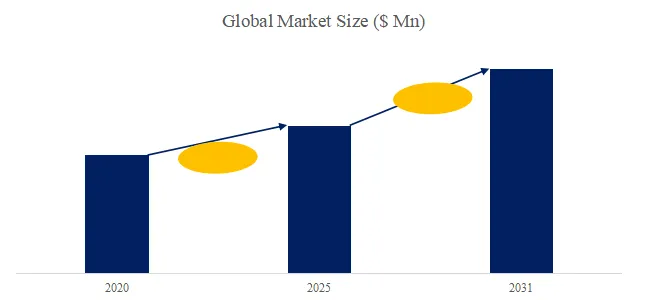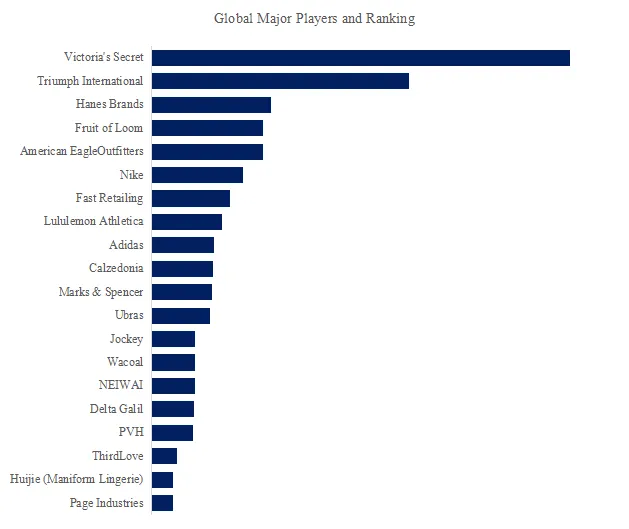Right Now
Lingerie Market Research:the global Lingerie market size is projected to reach USD 60 billion by 2031
Lingerie is fashionable and typically alluring undergarments. Lingerie includes undergarments using flexible, stretchy, sheer, or decorative materials like Lycra, nylon (nylon tricot), polyester, satin, lace, silk and sheer fabric. Certain cotton or synthetic undergarments are also lingerie.
Lingerie includes bras, thermal underwear, panties, swimwear, home clothes, socks and other types of clothing. The women's underwear described in this report is a narrow concept, that is, it only includes bra products.
According to the new market research report “Lingerie - Global Market Share and Ranking, Overall Sales and Demand Forecast 2025-2031”, published by QYResearch, the global Lingerie market size is projected to reach USD 60 billion by 2031, at a CAGR of 5.5% during the forecast period.
Figure. Global Lingerie Market Size (US$ Million), 2020-2031
Source: QYResearch, "Lingerie - Global Market Share and Ranking, Overall Sales and Demand Forecast 2025-2031”
Figure. Global Lingerie Top 27 Players Ranking and Market Share (Ranking is based on the revenue of 2024, continually updated)
Source: QYResearch, "Lingerie - Global Market Share and Ranking, Overall Sales and Demand Forecast 2025-2031”
According to QYResearch Top Players Research Center, the global key manufacturers of Lingerie include Victoria's Secret, Triumph International, Hanes Brands, Fruit of Loom, American Eagle Outfitters, Nike, Fast Retailing, Lululemon Athletica, Adidas, Calzedonia, etc. In 2024, the global top 10 players had a share approximately 29.82% in terms of revenue.
In terms of product type, currently Ordinary Lingerie is the largest segment, hold a share of 38.2%. Ordinary lingerie remains the largest category due to essential demand and fast fashion turnover. Nursing lingerie is seeing stable expansion driven by maternal health awareness and the convenience of online sales. Body shaping lingerie benefits from self-care trends and influencer-driven marketing, gaining traction in the mid-to-premium segment. Sports lingerie is the fastest-growing segment, supported by global fitness trends and the rise of athleisure fashion. Meanwhile, niche products like bridal or adaptive lingerie are gaining visibility due to inclusive fashion movements and specific functional demand. Overall, enhanced comfort, product functionality, and omni-channel distribution are the key factors driving category growth.
In terms of product application, currently Shopping Center is the largest segment, hold a share of 32.2%.
Although shopping centers are impacted by e-commerce, they still retain a certain appeal in first-tier cities and high-end markets, mainly relying on the brand aggregation effect and offline fitting experience to attract consumers; specialty stores are still an important position for brands to establish loyalty and promote new models, especially in the mid-to-high-end and customized markets, with sustained growth potential; supermarkets are more focused on basic models and price-sensitive consumers, and although the gross profit margin is lower, they are still an important coverage channel in emerging markets; online sales are currently the fastest growing channel, benefiting from the popularization of mobile e-commerce, social media marketing and the development of AI fitting technology, especially among young consumers and third- and fourth-tier cities. Overall, the integration of online and offline will become the mainstream trend, and the ability to deploy multiple channels has become an important measure of brand competitiveness.
Lingerie Market Dynamics
Market Drivers:
Rising Body Positivity and Self-Confidence Trends: The increasing social acceptance of diverse body types and the growing emphasis on self-expression are fueling consumer demand for varied and inclusive lingerie lines, especially in developed markets. Brands that embrace body inclusivity and size diversity are gaining significant traction.
Evolving Fashion and Lifestyle Preferences: Modern consumers view lingerie not just as functional wear but as an extension of personal style and comfort. The blending of fashion and intimate wear (e.g., bralettes as outerwear) is expanding the role of lingerie in everyday fashion.
Increased Disposable Income and Urbanization: Particularly in emerging economies (India, Southeast Asia, Brazil), growing middle-class populations with rising purchasing power are boosting sales of premium and fashion-forward lingerie.
Expansion of E-Commerce and Direct-to-Consumer Channels: Digital-first lingerie brands are leveraging online platforms, AI-based fitting tools, and social media marketing to personalize customer experiences and reduce friction in the buying process.
Restraint:
High Price Sensitivity and Fragmentation: The lingerie market, especially in price-conscious regions, remains highly fragmented, with unorganized players offering low-cost alternatives. Premium brands often struggle to justify higher pricing without strong brand equity.
Cultural and Societal Barriers: In conservative regions, such as parts of the Middle East or South Asia, open discussion and retail display of intimate wear can be culturally sensitive, limiting market visibility and retail strategies.
Sizing Inconsistencies and Fit Issues: One of the most persistent challenges in the lingerie industry is fit accuracy. Poor sizing standards across brands result in high return rates and customer dissatisfaction, particularly in online channels.
Opportunity:
Personalization and Fit-Tech Integration: Use of 3D scanning, AI sizing tools, and machine learning to recommend ideal fits is reducing returns and enhancing satisfaction. Companies that invest in such technologies stand to gain a competitive edge.
Collaborations and Limited-Edition Drops: Collaborations with celebrities, influencers, and fashion designers (e.g., Rihanna’s Savage X Fenty, Victoria's Secret rebranding) are proving successful in driving engagement and premiumization.
About The Authors
Airong Wang– As a Junior Analyst with two years of experience at QYResearch, I specialize in market research and the preparation of in-depth industry reports. With a strong foundation in data collection and analysis, I effectively identify key market trends, assess competitive landscapes, and provide actionable insights for clients.
Leveraging my academic background in logistics and auto, I bring a technical understanding of the industry, which enhances the quality of my analysis and reports. My expertise lies in conducting feasibility studies, identifying growth opportunities, and helping businesses make informed, strategic decisions.
Email: wangairong@qyresearch.com
About QYResearch
QYResearch founded in California, USA in 2007.It is a leading global market research and consulting company. With over 17 years’ experience and professional research team in various cities over the world QY Research focuses on management consulting, database and seminar services, IPO consulting, industry chain research and customized research to help our clients in providing non-linear revenue model and make them successful. We are globally recognized for our expansive portfolio of services, good corporate citizenship, and our strong commitment to sustainability. Up to now, we have cooperated with more than 60,000 clients across five continents. Let’s work closely with you and build a bold and better future.
QYResearch is a world-renowned large-scale consulting company. The industry covers various high-tech industry chain market segments, spanning the semiconductor industry chain (semiconductor equipment and parts, semiconductor materials, ICs, Foundry, packaging and testing, discrete devices, sensors, optoelectronic devices), photovoltaic industry chain (equipment, cells, modules, auxiliary material brackets, inverters, power station terminals), new energy automobile industry chain (batteries and materials, auto parts, batteries, motors, electronic control, automotive semiconductors, etc.), communication industry chain (communication system equipment, terminal equipment, electronic components, RF front-end, optical modules, 4G/5G/6G, broadband, IoT, digital economy, AI), advanced materials industry Chain (metal materials, polymer materials, ceramic materials, nano materials, etc.), machinery manufacturing industry chain (CNC machine tools, construction machinery, electrical machinery, 3C automation, industrial robots, lasers, industrial control, drones), food, beverages and pharmaceuticals, medical equipment, agriculture, etc.
Contact Us:
If you have any queries regarding this report or if you would like further information, please contact us:
QY Research Inc.
Add: 17890 Castleton Street Suite 369 City of Industry CA 91748 United States
E-mail: global@qyresearch.com
Tel: 001-626-842-1666(US) 0086-133 1872 9947(CN)
EN: https://www.qyresearch.com
JP: https://www.qyresearch.co.jp
More Posts



















Report This Post
Please complete the following requested information to flag this post and report abuse, or offensive content. Your report will be reviewed within 24 hours. We will take appropriate action as described in Findit terms of use.


